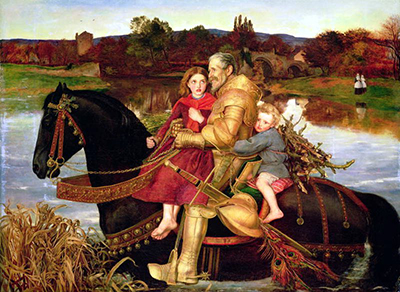The painting was done in 1857 by Sir John Everett Millais. It is an indication of the Pre-Raphaelites interests in medieval chivalry. It portrays an ancient knight riding on horseback across a river and with him are two woodcutter's children.
The children in the drawing are carrying a burden of wood. The painting's background is based on a medieval bridge, Bridge of Earn, which was in ruins in Perth shire. Villages can also be seen in the background, but the castle is an imaginary addition in the art. A Dream of the Past: Sir Isumbras at the Ford is a title derived from the 14th century medieval English Romance also titled Sir Isumbras. The illustration in the painting was not from the original tale but came from a fake medieval verse that was penned by Tom Taylor who was Sir John Everett’s friend and also an art critic. The original text describes a knight who was arrogant but later humbled due to misfortunes he encountered during his youth. The tale was derived from Saint Eustace’s legend and Book of Job. The character of Sir Isumbras portrayed in the artwork shows a humbled knight after the events described in the poem by Frederic George Stephens.
The original literary painting depicts a romanticism style. It measures 171.5 centimeters in height and a 125.5 centimeters in width. For the painting, the artist used bright colors in his drawing which is a style seen in all the Pre-Raphaelite’s works. On exhibition, the artwork received hostile reviews from art critics such as John Ruskin for painting a horse that was out of proportion. The critic condemned Sir John Everett for making what he termed as “pictorial grammar” errors. It was also satirized in a print called “Nightmare” by Frederic Sandys. The painting background lacks the artistry that Sir John Everett portrayed in his earlier work and looks loose and light instead of having a detailed painting style.
Sir John Everett completed the artwork for an exhibition in the Academy of Arts. Following the controversy, he attempted to do some repaints before sending it to a Liverpool exhibition. Currently, it is a collection of the Lady Lever Art Gallery in Port Sunlight, UK. The painting draws influences from the theme of Christian Chivalry and also The Knight, Death and the Devil art by Albert Durer's print.




